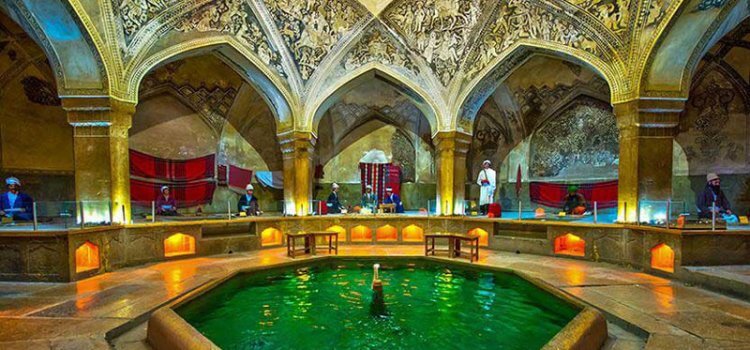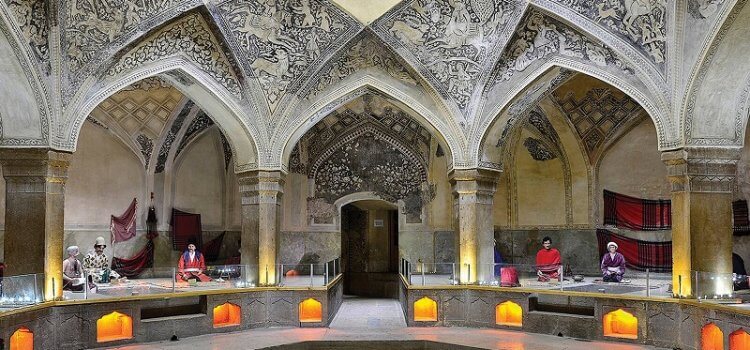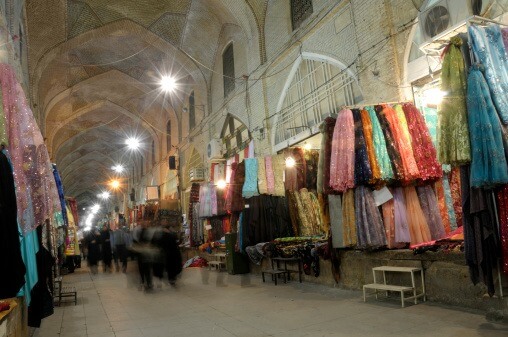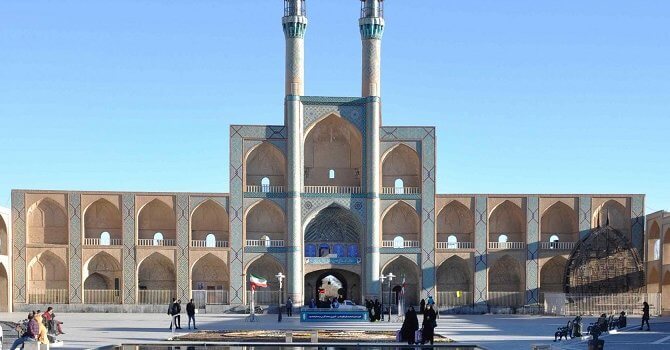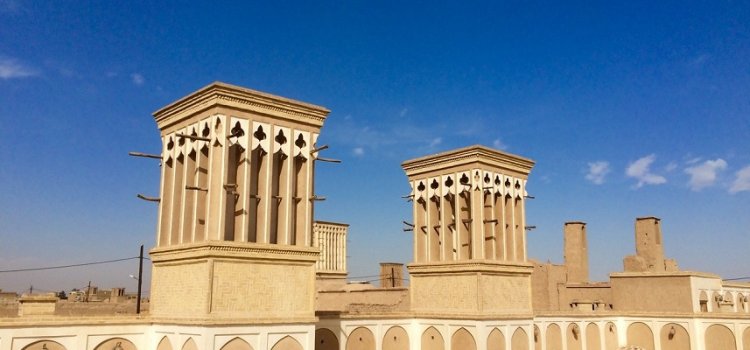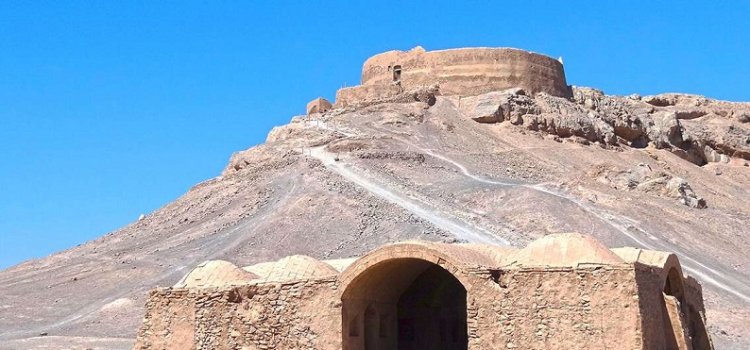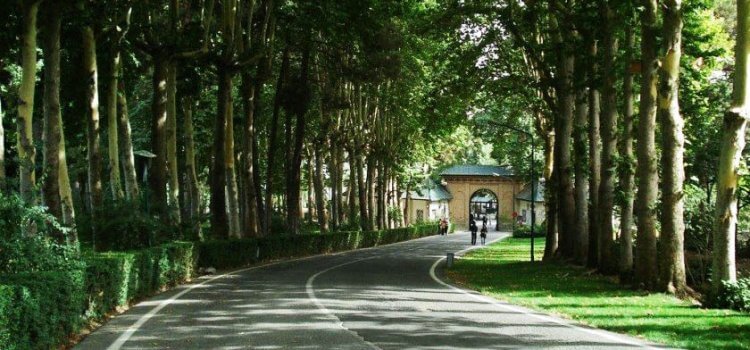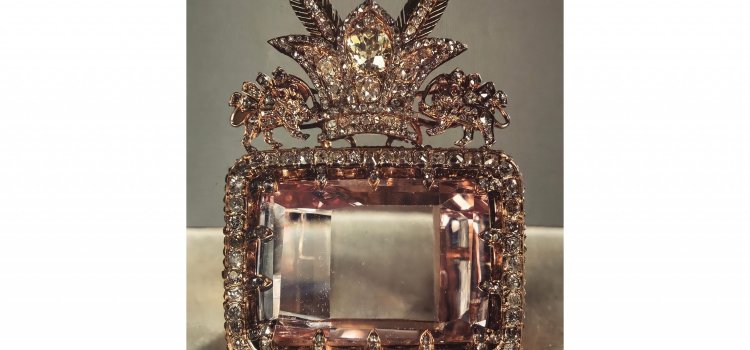Vakil Complex in Shiraz
After a long struggle for power, Karim Khan Zand settled permanently in Shiraz in the year 1765, founding the Zand dynasty
Vakil Complex in Shiraz
After a long struggle for power, Karim Khan Zand settled permanently in Shiraz in the year 1765, founding the Zand dynasty. Interestingly, he declined to assume the title of Shah, calling himself “Vakil al-Ra’āyā” (Deputy of Subjects) or “Vakil al-Khalayegh” (people’s deputy). As Vakil, he used to wear very simple clothes, putting on the tall Zand turban of yellow cashmere and sitting on a cheap, flat-weave rug (zilu) instead of a throne.
With the establishment of his power, Karim khan began building a new series of monuments in shiraz, what is today known as Vakil or Zandiyeh complex. The complex includes the Citadel of Karim Khan, Vakil Bazaar, a mosque and also a bath-house.
The good thing about Vakil Complex is that all these monuments are located closely to each other and you can visit all of them simply by walking. In addition, many other touristic sights are located in the vicinity of this complex and you have easy access to them.
In this article, we are you going to introduce each of these buildings briefly and since these are must-see attractions in Shiraz, we strongly recommend you to read it before visiting these precious monuments
Vakil Bath
Vakil Bath
Just located to the right of the Vakil Mosque, there is the Vakil Bath, built by Karim Khan as one of the largest traditional bath-houses in Iran.
The bath, mainly built of brick, gypsum mortar and stone, includes an entrance portal on its northern side, connecting the outer and the anteroom through a low door with a light slope. This technique used in many of traditional Iranian bathrooms is used to avoid the evasion of hot air from the bath.
The anteroom, adorned with arabesque designs, directs to a chamber used as the dressing room of the bath. This room, which is octagonal in shape, is decorated with eight monolithic stone columns. Furthermore, the walls of the bath are adorned with stucco molding in floral and geometric patterns. Also, a big pool is built in the middle of this room, with some empty spaces around which were used as shoe boxes.
A corridor where the latrines are situated connects the dressing room to what is in Persian architecture called Garm-khaneh or literally the heat house. The heat room enjoys a square plan with four rock columns, topped by a canopy of vaults. Hot water canals passed under the floor covered with stones. The dados are built out of green marble plates, imported from Tabriz. In addition, there are two deep niches with a large stone pool in front of them which were dedicated to the nobiles. The outstanding decorations of this part of Vakil Mosque are the plaster designs created in the Qajarid era (19th century) covering the Zand designs.
Also, the wax figures and a voice-over speaking in the sweet Shirazian accent represent and describe the different procedures of bathing in the Zand era. As it becomes clear little by little, the bathrooms were not only a place used for personal hygiene, but also a gathering place in which different ceremonies were held. A famous marriage ceremony, called ‘Henna Bandan’ in which the groom’s relatives put Henna on bride’s hands as a symbol of joy and fortune, is demonstrated in one the rooms of the Vakil Bath, using wax figures and playing the music played in this ceremony. So, by visiting the Vakil Bath, you will not only get familiar with one of the architectural gems of the Zand period in Iran, you will also get familiar with a number of Iranian cultural traditions. Therefore, make sure not to miss visiting the Vakil Mosque during your trip to Shiraz.
Vakil Bazaar
Vakil Bazaar
One of the highly attractive parts of Vakil Complex, in which every tourist and visitor can spend hours and hours without being bored, is no doubt the Vakil bazaar of Shiraz.
Inspired by the Safavid Bazaar of Lār, a city near Shiraz, Karim Khan ordered the construction of Vakil Bazaar. The completion of the bazaar took about four years, from 1770 to 1774.
The Vakil Bazaar, stretching from North to South, is composed of two perpendicular archways. The Northern and Southern parts of the bazaar, called rasteh, included eighty-two shops, while the Western and Eastern rastehs lodged twenty and thirty-eight shops respectively.
In addition to shops, Vakil Bazaar hosts several workshops, storerooms and caravansaries. The caravansaries in the eastern, western and northern sides of the bazaar are called Rowghani, Ahmadi, Qawami and Gomrok. There is another caravanserai built on the Western wing of bazaar known as Fil caravansary (elephant caravansary). Fil Caravanserai was built in 1766, mostly housing the offices of merchants active in the bazaar. Unfortunately, some parts of Qawami and Rowgani caravanserais, as well as eight arches of the bazaar, were demolished due to urban expansion undertaken during the Pahlavi I era.
Having been an international trade center, Vakil Bazaar now contains 180 shops, mostly selling spices, rugs, carpets, copper handicrafts and antiques. The highlight of the bazaar is the Qajarid Saray-e Moshir, built by Mirza Abolhassan Khan Moshirolmolk in the 19th century. Being located at the southern end of the bazaar, Saray-e Moshir is comprised of a large pool in the middle surrounded by four flower beds and also shops on its western and eastern sides. Local souvenirs and handicrafts are being sold in this bazaar and caravanserai.
The Citadel of Karim Khan (Arg-e Karim Khan)
The Citadel of Karim Khan (Arg-e Karim Khan)
To build his citadel, Karim Khan invited the best national and international architects to come to Shiraz and design the arg. In addition
The Citadel of Karim Khan (Arg-e Karim Khan)
To build his citadel, Karim Khan invited the best national and international architects to come to Shiraz and design the arg. In addition, he ordered the best construction material be brought to Shiraz to be used in building this magnificent citadel.
As you approach the citadel of Karim Khan, its unique brick-work and tall watch-towers attract your attention. Entering the citadel, make sure to spend some minutes probing the painting just above the entrance gate. It represents Rostam, the most famous mythic hero in Iranian culture, killing the white div or demon. The theme of this Qajarid painting (19th century) is borrowed from epic book Shah Nameh (the Book of Kings) by the famous Iranian poet, Ferdowsi.
By the way, passing the entrance gate and vestibule, you will enter the courtyard of the citadel. Following the general plan of well-known Persian Gardens, the courtyard is divided into several orange groves and four ponds at the four corners of this appealing garden. Again, confirming the general pattern of Persian Gardens, the longest pool is located on the eastern side of the complex, right in front of the door you entered the courtyard.
On the Western, Northern and Southern parts of the citadel, there are three porches, each one decorated with two high-rising columns. Flanking these porches, there are rooms in various sizes which once hosted both the family of Karim Khan and his formal guests.
Inside the rooms, you can feast your eyes on beautiful decorations such as arabesque and floral patterns featuring Persian flower and bird (Gol-o morgh) motifs. These patterns, which were mostly common in Shiraz, were painted in vivid colors and gilt on the upper parts of the walls and ceilings. The ceiling’s ornaments were painted using herbal colors and gold plates. Furthermore, the interior used to be abundantly decorated with tiles, marbles, plaster works and gilded paintings. In addition, large mirrors, brought from Russia, Europe, and Ottoman lands were installed here.
The outer façade of the rooms, especially their plinths, are decorated with large carved stone panels, bearing designs mostly borrowed from Persepolis.
Amir Chakhmakh Square
Amir Chakhmaq, this is how the main square of the city of Yazd is called. It bears the name of its builder, the governor of Yazd in the 15th century, under the rein Timurid.
Amir Chakhmakh , this is how the main square of the city of Yazd is called. It bears the name of its builder, the governor of Yazd in the 15th century, under the rein Timurid.
Built as a complex, including among others a bazaar, a mosque and a cistern. Its arcaded facade with its minarets were added in the 19th century.
The changes made have given the place the appearance of Hosseinieh(
place of commemoration of the martyrdom of Imam Hossein, a high religious figure of Shiite Islam) normally constructed in Yazd.
On the square, in front of the facade with multiple arches, sits a sort of ceremonial wooden structure, this object named Nakhl (palm tree), is decorated in black during the Moharam ceremonies, and is carried on the shoulder by the men themselves dressed in black. This procession marks the culmination of the commemoration ceremonies.
Fahadan
Fahadan is the old Yazd district that constitutes the nucleus of the old city.
Fahadan: The Soul and Spirit of Oriental Adobe Neighborhoods
Have you ever watched the Disney’s “Aladdin” or played the video-game “Prince of Persia”? If so, didn’t you dream of jumping roofs along with your brave heroes to save the beautiful princess from evil hands? Yes!? So, join us to go and visit Fahadan in the city of Yazd, a neighborhood which could be the location of one these cartoons and at least partially realize your dream.
Fahadan, the largest adobe neighborhood in the world and a UNESCO World Heritage Site since 2017, is located in the heart of Yazd city. Travelers reviewing their memories from this historical neighborhood would always tell you of its long and high adobe walls, sābāts (roofed passageways), magnificent houses with marvelous wind-catchers, traditional workshops producing handicrafts and textiles, amazing mosques, religious schools and finely-decorated shrines. However, what is most striking for all of these visitors is the warm and hospitable attitude of the people living in this old neighborhood; inhabitants whose patience, hard work and perseverance has kept this old neighborhood alive, making it one of the most appealing tourist attractions in Iran.
Well, if you would like to know more about this awe-inspiring neighborhood, please continue reading our article.
Some Points You Need to Know about the Fahadan Neighborhood
Well, as the architectural style of Fahadan neighborhood reveals, it is one of the oldest neighborhoods in the city of Yazd. Based on historical evidence, this neighborhood was the residence of influential Yazdi people, thus providing us with one of the meanings of Fahadan: “Wise Men.” Also, signifying “cheetah,” it is believed that certain people in this neighborhood were in the peculiar business of training cheetahs.
The prominence of Fahadan as the beating heart of Yazd is also evident in being surrounded by significant monuments such as Bazaar-e No and Vaght-o-Sa’at Square on its southern side and Kooshk-e No and Shah Abolqasem Tomb on its western wing.
More importantly, Fahadan itself is spotted with more than 25 historical, architectural and cultural attractions, adding to its splendor and significance. In what follows, you will get acquainted with some of these gems you should not miss visiting while exploring Fahadan neighborhood.
Must-See Sights in Fahadan Neighborhood
Jameh Mosque of Yazd (the Grand Congregational Mosque of Yazd)
Just at the entrance of the Fahadan Neighborhood, there is located the Jameh Mosque of Yazd whose eye-catching beauty will no doubt mesmerize. It is believed that the mosque is founded on the ruins of a Zoroastrian fire temple, stretching its history back to pre-Islamic times.
However, what would grab your attention at first glance are the mosque’s two soaring minarets, allegedly the tallest minarets belonging to a mosque in Iran, each one 52 meters in height.
Inside, the dome chamber and its fantastic faience work make the most attractive part of the mosque. Usually, visitors spend a good deal of time taking photos while framed by these works of art to upload on their social media.
Another interesting part of the mosque is the water-cistern and its long flight of stairs, putting your fitness on trial to reach water.
Alexander’s Prison or Ziyaiyeh School
Walking through the winding alleys of Fahadan neighborhood will eventually get you to a square where some of the oldest buildings in Yazd impatiently await your visit. One of these buildings, whose history has been mixed with myth, is the Alexander Prison or Ziāiyeh School.
According to legend, having conquered the land of Persians, Alexander made up his mind to build a prison in which to keep the defeated prisoners of war. Considering different options, nowhere suited his plan better than Yazd, an arid, parched land whose geographic location made it an inaccessible land. And so Alexander’s Prison came into being.
However, it seems that the appearance of the name “Alexander’s Prison” in the historical chronicles of the Safavid period is inspired by Hafez’s famous couplet:
“I am upset over the horrors of Alexander’s Prison
Fading away to Solomon’s Kingdom”
In which the poet compares Yazd to Alexander’s Prison and Shiraz, his hometown, to Solomon’s Kingdom.
As a matter of fact, an examination of historical sources reveals that this monument was constructed as a school under the patronage of Mowlana Zia al-Din in the year 1234. Soaring high toward the sky, the adobe dome of Ziaiyeh school, decorated with splendid stucco work and water-color paintings, represents one the best pieces of architecture from the Mongol period in Iran. In addition to its dome and dome chamber, the school includes three porches, several different rooms and an underground water-cistern whose dark and scary ambience makes it look like a dungeon.
Today, the school hosts various handicraft workshops and there you can find marvelous souvenirs for your loved ones not having the opportunity to visit Iran.
The Tomb of Twelve Imams
The Tomb of Twelve Imams is one of the oldest monuments in Fahadan, built in the 11th century. The tomb has a simple quadruple plan with a brick dome. According to Arthur Upham Pope, the significance of the building lies in solving the problem of placing a semi-circular dome on a quadrilateral foundation. In the previous buildings, the area of transference was not strong enough to bear the downward pressure of a heavy dome, but in the Tomb of Twelve Imams this engineering problem is overcome in the best way possible, resulting in the construction of a perfect dome on a quadruple base.
The function of the monument is actually a bit vague. Some people believe that it is the burial place of a scared person, others are of the opinion that the building was used as a Khaneqah, or a gathering place for mystics and dervishes.
Lariha House
Lariha House is one of the most beautiful mansions in Fahadan, located in the vicinity of Alexander’s Prison and Tomb of Twelve Imams. This Qajarid (19th century) mansion was actually a complex of six houses, built by Haj Mohammad Lāri, a rich, powerful businessman from Shiraz city who came to Yazd for trade purposes.
Following the general plan of desertic houses, Lariha House boasts amazing sash windows, splendid mirror works and eye-catching paintings. The highlight of the house is its “Otagh-e Aroosi” or “Bridal Room,” decorated with European-style paintings of women.
In addition to enjoying the artistic beauties of the mansion, you will also get acquainted with traditional ways of marriage in Iran as the mansion also functions as a museum, putting on display the marriage documents of long gone couples who tied the knot years and years ago.
All in all, wandering through the winding paths of Fahadan neighborhood, visiting its historical monuments, spending some time in its traditional workshops and drinking a cup of coffee in one of its cozy coffeeshops makes one of the most pleasant days during your adventures in Iran. I am sure you would never forget your delightful moments in Fahadan Neighborhood.
Tower of Silence
Zoroastrian Dakhmeh or the tower of silence was built in 1672 in Yazd.
Yazd Towers of Silence: Two Zoroastrian Soaring Graveyards
Yazd is one of the major tourist attractions in Iran not only because of housing the largest adobe neighborhood in the world (a UNESCO World Heritage Site), but also because of hosting a Zoroastrian minority whose unique way of life has contributed largely to fame of this old city.
In another article, we have extensively talked about the Fire Temple of Yazd, the house of the ancient religion of Iran, Zoroastrianism. In this article, we are going to tell you about a Zoroastrian’s journey to his/her permanent house after life. To achieve this goal, in this article we explore the old graveyard of Zoroastrians in Yazd, called Dakhmeh (Dakhma) or Towers of Silence, and also the death rituals performed there.
So, make sure to read our article to learn whatever you need to know before setting foot in this unique Zoroastrian land of the dead, The Towers of Silence.
Khorshid Negareshi or the Zoroastrian Death Ritual
Zoroastrianism was the state religion of Iran during the rule of the Achaemenid and Sassanian dynasties. As part of their religious code, Zoroastrians believed in the purity of the four fundamental elements of the universe, that is, the air, the earth, the wind and the fire. Consequently, polluting these four essential elements was considered a grave sin.
In this context, the corpse of a dead person was considered as the greatest pollutant of the four elements. But why? Well, Zoroastrians saw a live human body as the house of a pure spirit. However, whenever the death intervened, this pure spirit left the body, giving up his abode to an impure, satanic one. Obviously, this impurity was not allowed to touch the four pure elements. Therefore, instead of burying their dead, throwing them into the water or cremating them, Zoroastrians left the dead bodies on high places to be scavenged by vultures and dried by sun and, finally, washed away from the surface of the Earth. Among Zoroastrians, this process is known as “Khorshid Negareshi” or “observed by the sun.”
To perform the ritual of “Khorshid Negareshi,” certain structures were also needed to be built. These secluded monuments, a mysterious stretch of land in the realm of death, came to be known as “Dakhmeh.”
The appellation “Towers of Silence,” used mostly by Western writers, is said to be coined by Robert Murphy, a translator for the British colonial government of India in early 19th century.
The structure of Towers of Silence
As mentioned before, towers of silence were build atop hills or low mountains, outside the surrounding villages or towns, to keep people away from poisonous gases emanating from the decomposing bodies. Generally speaking, towers of silence were circular in shape, fenced with high walls constructed out of stone and cement and equipped with a low iron door for entry and exit.
The inner area of the tower was basically divided into three concentric circles or “Pavis”: the outer, largest pavi was dedicated to the bodies of men, the middle one to women and the inner pavi, the smallest one, to babies and kids.
These stone-carpeted divisions were slightly sloped toward a well in the middle of the tower, known as “Ostoudan” or “Saradeh.” Functionally, ostoudan was used as an ossuary. Actually, when the bodies were scavenged by birds like vultures and bleached by the sun, the bones were collected and thrown into the ostoudan.
Additionally, the main ostoudan was connected to four other wells through different tunnels. Dug outside and around the main tower, these wells were filled with coal. So, whenever it rained, the water washing the pavis and the bones in the ostoudan was channeled to these extra wells and purified by passing through the piles of coal. In this way, the area surrounding the tower was kept clean.
But, how did people get to the towers? Well, reaching the towers was made possible by a long flight of stone stairs, taking people from the foot of the hill or mountain to its peak.
A Short History of Yazd Towers of Silence
The Towers of Silence in Yazd actually includes two towers: 1. Manokji Limooj Haterya and,2. Golestan. Below we give you a brief history of these two towers, built during the 19th and 20th centuries.
- Manokji Limooj Haterya
This Dakhmeh was built by Manokji Limooj Haterya, a Parsee living in India, in 1856. At its entrance, on a stone inscription, the date and name of its founder were mentioned. Furthermore, at the entrance of the dakhmeh, there is a chamber. Earlier, there was another stone inscription mentioning the construction of building by Manojki. In the inscription, Muslims and Zoroastrians are advised not to touch the corpse of their dead person according to their documented reports.
Maokji Dakhmeh is built with stone. Its interior is divided into three parts, as we mentioned before. The floor of the dakhmeh is flat and paved. Its interior diameter is 28.40 m and the ossuary’s diameter is 10 m.
- Golestan Dakhmeh
This monument was built as a circular tower in 1931. The tower’s diameter is 29.40 m and the diameter of the ossuary is 5.40 m. To reach Golestan Tower, you should ascend a rocky road, about 2 meters wide. The tower is constructed out of stone, but the walls are covered with thatch and plaster. There is a brick chamber next to the entrance of the dakhmeh. It seems it was used by the tower’s guard or for arranging the ceremony before putting the corpse into the tower. The walls of the tower are three meters high.
Other Structures Found in Yazd Towers of Silence
Entering Yazd Towers of Silence, in addition to the main two towers mentioned above, you will notice a number of structures scattered at the foot of the hills. Taken together, these monuments make a complex known as Kheyleh, used during the mourning ceremony or “Porsea” of the departed person. The monuments include:
- Water Cistern: The Kheyleh in Yazd Towers of Silence includes a water-cistern, biasting two delicately designed brick-lattice wind-catchers. To reach the water, you have to descend two flights of stairs; the first one composed of thirty steps and the second one of fifteen steps. This water-cistern was built by Fereydoun Khosrow Ghasemabadi in memory of his wife, Nasrin Rashidi.
- Fire Temple: Adjacent to the dakhmeh, there used to be a conical fire temple, housing the sacred court fire. Whenever a person died, the guard attending the fire temple kept the court fire alight for three days in memory of the deceased. For this reason, the guards were also called “fire burners”.
- a room for the fire temple’s guard,
- a room for Nesa-Salar,
- rooms to hold the mourning ceremonies,
- rooms for storing the corpse and antiseptic material,
- and, finally, several shafts to which people fastened their animals.
Zoroastrian Funerary Ceremony
When a Zoroastrian person passed away, his relatives closed their eyes, put their hand on the chest and folded their legs up to his knees in order to be placed in a casket and carried easily.
Then, he was washed at home and put on the ground or an iron bed to be covered with a nine-folded clean shroud. Then, those present recited some parts of the Avesta or Gahanbar as a requiem for the departed.
After these ceremonies at home, the corpse carriers or “Pishgahanan” carried the dead bodies to dakhmeh. The number of attending pishgahanan was always even, that is, two, four or six.
In dakhmeh, they put the corpse in the hands of Nesa-Salar. The male nesasalar washed the males and the female nesasalar washed the females. Then, the corpse was put in a metal casket called “Gahn” or “Gahan” and taken to the main tower to go to his eternal abode.
In the past days, to ensure that a dead person was really dead, Zoroastrians put a sacred loaf of bread, called “Draona”, on the chest of the deceased. Afterwards, they brought a dog to corpse. If the trained dog didn’t eat the bread, they understood that the person was for example in comma as a result of a stroke. But if the dog took the bread, it meant that there was no cause to doubt the death of the departed. So, the corpse was carried to dakhmeh.
Before reaching the dakhmeh, there was a building in which the dead person’s relatives offered food, fruits and drinks for the forgiveness of the dead soul. There, as the last step, the pries read a special prayer from Ahunavaiti Gathas before the corpse.
The New Cemetery of Zoroastrians
The ceremony of Khorshi-Negareshi continued until the years 1318 and 1319. However, when Reza Khan came to power, Zoroastrians were prevented to use the towers of silence in certain cities such as Tehran. Consequently, Zoroastrians began burying the dead in graves, fortified with cement and rock in order to avoid the contamination of the soil. It is believed that Zoroastrians stopped using the towers since the 1320s in Kerman and since the 1340s in Yazd. However, there are some who believe that the dakhmehs were closed in Yazd in the year 1350.
Saad Abad Palace
Saadabad Palace or in other words Saadabad Palace collection is a collection of palaces and royal buildings in an area of 110 hectares at the foot of Tochal Mountain located in the north of Tehran
Saadabad Palace or in other words Saadabad Palace collection is a collection of palaces and royal buildings in an area of 110 hectares at the foot of Tochal Mountain located in the north of Tehran.These buildings were originally inhabited by court officials during the Qajar period in a much smaller area, but Reza Shah took possession of it after the coup of 1920 and during its reign greatly expanded it and increased the number of palaces, then Mohammad Reza Pahlavi’s family settled there after his coronation in the 1970s. This huge and extraordinary complex has 8 gates, 12 aqueducts and 20 palaces.
The gates of Saadabad Palace
The gates of Saadabad Palace include:
1) Nezamieh Gate
2) Zafaranieh Gate
3) Darband street gate
4) Darband Square door
5) Jafarabad Gate (First)
6) Jafarabad Gate (Second)
7) River gate
8) White House Gate
Out of these 8 gates, currently only the gates of Darband and Zafaranieh are open to the public.
Saadabad Palace Complex
Most of the palaces of this magnificent complex, which were the residence of the court and the royal family during the Qajar and Pahlavi eras, have now been converted into spectacular and luxurious museums and have become places to explore history and culture; They are in the possession of the presidential institution or office building. These palaces and their use today include:
1) White Palace or Nation Palace (Museum Palace)
2) Black House (Museum of Fine Arts)
3) Farah Pahlavi Palace (Negarestan Museum)
4) Shahram Palace (Military Museum)
5) Queen Esmat Dolatshahi Palace (Farshchian Museum)
6) Leila Pahlavi Palace (Miniature Museum of Master Abkar)
7) Pahlavi Shams Palace (Museum of Anthropology and Royal Clothing)
8) Ashraf Pahlavi Palace (Royal Tableware Museum)
9) Farahnaz and Alireza Palace (Mir Emad Calligraphy Museum)
10) Queen Turan Amir Soleimani Palace (Museum of Eternal Figures)
11) Ahmad Reza Pahlavi Palace (Library)
12) Karbas Palace or Crown Prince Palace (Behzad Master Museum)
13) Green Palace or Shahvand Palace (Museum Palace)
14) Gholamreza Pahlavi Palace (Museum of Court Weapons)
15) Queen Mother Palace known as the Republic Building (accommodation of special guests of the Government of the Islamic Republic of Iran)
16) Private palace (at the disposal of the Presidential Institution of Iran)
17) New Crown Palace (at the disposal of the Presidential Institution of Iran)
18) Bahman Palace (Museum Management Office)
19) Abdolreza Pahlavi Palace (Saadabad complex office building)
20) Ahmad Shah Palace
The other three museums in the complex include the Omidvar Brothers Museum at the Qajri Carriage House, the Water Museum at the Office of the Chief of Staff, and the Museum of Art at the White House Greenhouse.
Since it is not possible or necessary to explain all these palaces and museums, we will explain some of the most important palaces and museums of Saadabad Palace historical and cultural complex.
White Palace or Nation Palace (Museum Palace)
The largest and most luxurious palace in this complex is the White Palace or the Palace of the Nation with two floors and a white facade
The largest and most luxurious palace in this complex is the White Palace or the Palace of the Nation with two floors and a white facade, which was the summer residence of Mohammad Reza Pahlavi and his queen Farah. The construction of this palace began in 1310 by the order of Reza Shah and this palace was the place of ceremonial ceremonies after Mohammad Reza Pahlavi and Farah Diba settled in it. Mohammad Reza Pahlavi’s office and his and Farah Pahlavi’s rest rooms, as well as their private living room and its reception hall on the second floor, are among the most important rooms of this palace, with crystals and decorative chandeliers, precious carpets and oil paintings by Behzad They have accommodated his disciples. Many of the accessories in the palace reception halls are made from French auctions and antique shops, and the design of these halls is in the French style.
The Royal treasury of Iran
The Royal treasury, probably an unparalleled collection in the world is currently housed in the basement of the Iran Melli Bank.
The Royal treasury of Iran
The Royal treasury, probably an unparalleled collection in the world is currently housed in the basement of the Iran Melli Bank. The accumulation of this treasure dates back to the Safavid era in the 17th century. After the conquest of India by Nader Shah, he brought back a great deal of precious stones including the two largest pink diamond in the world, sea of light and mount of light. The latter later possessed by british army and is now on the crown of the queen.
In the Qajar era, once again, Fath Ali shah took possession of it and the personal interest of the Qajar kings added quite a few new gems to it, which were partly bought and some counted among the diplomatic gifts.
In 1937 a law required that the treasury be transferred to the Melli (national) bank as the financial endowment of national currency.
The treasury has been prepared and opened to the public with very restricted visiting times.
Among the unique jewels, we can name
The crown of the Pahlavi Dynasty of 2080 grams, used by Reza and Mohammadreza Shah in their coronation ceremony. The famous diamond Daraye-Noor (sea of light) of 182 carats in pink color.
The Kiani crown, belonged to Fath Ali shah and other Qajar kings, set with a 120 carat garnet.
The jeweled globe, made in 1869 by the order of Nasserdin-shah was made basically with 3656 grams of gold with 51366 precious stones mounted on it.
The peacock throne (in Persian named Tawouss, beloved of Fath Ali Shah) dating from the beginning of the 19th century.
Note the visiting hours are from 2:00 p.m. to 4:30 p.m. Open Saturday through Tuesday under strict control.

